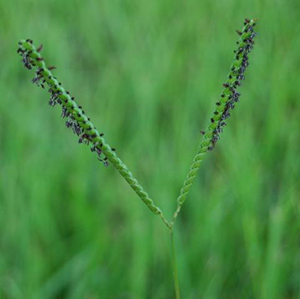Bahiagrass

Bahiagrass seedhead. The purple anthers can be observed covering each raceme. Credit: Carlos Acuna, UF/IFAS
Florida gardeners can choose from several types of lawn grasses, including bahiagrass (Paspalum notatum Flugge). It was originally introduced to Florida as a pasture grass, but is also a low-maintenance option for home lawns. A popular cultivar for home lawns is 'Argentine'.
Many people who opt for a bahiagrass lawn do so because of its relatively low maintenance needs. Because bahiagrass forms an extensive root system, it has better drought tolerance than other Florida lawngrasses. Bahiagrass also needs fewer nutrients than other turfgrasses and has fewer problems with insect pests and diseases.
However, bahiagrass doesn't provide the same uniform cover that other grasses do, and some people find its tall seedheads unattractive.
Bahiagrass can be established as sod or seed. Bahiagrass can be established any time of year in much of Florida, but in North Florida, the best time to establish bahiagrass is during the spring or early summer months.
During times of active growth, bahiagrass should be mowed every 7–14 days to a height of 3–4 inches. Because bahiagrass leaves and seed head stems are very tough, the mower blade must be sharpened regularly to ensure a good, clean cut. If this is not done, the leaves may be torn by the mower blades, which can lead to disease or insect problems and leave the grass with a ragged appearance. The most serious insect threat to bahiagrass is the mole cricket

